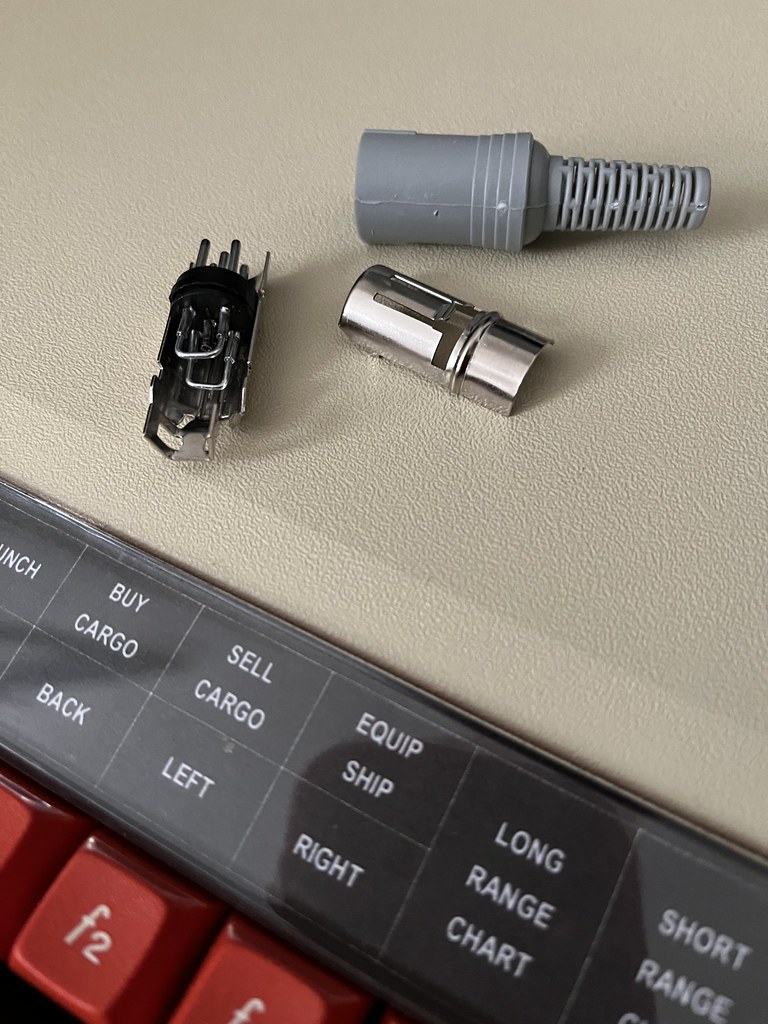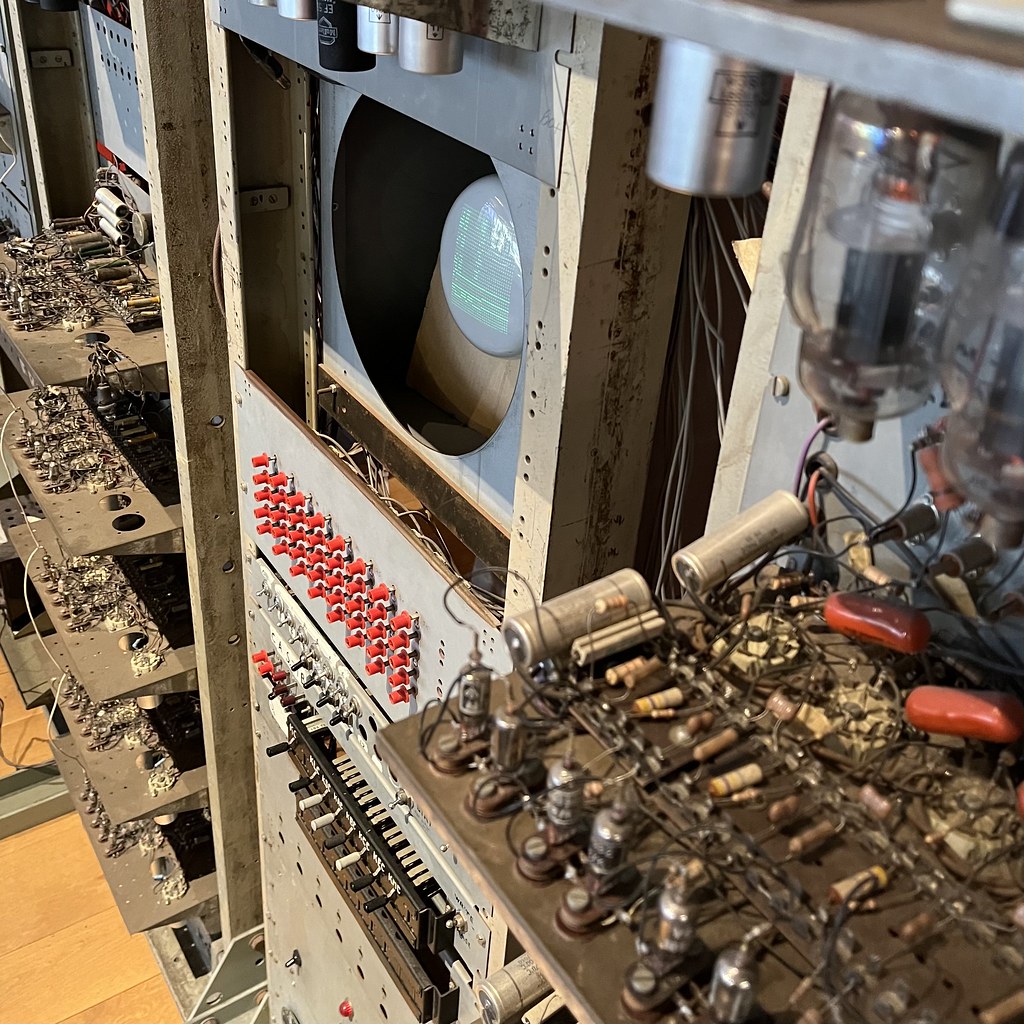You are using an out of date browser. It may not display this or other websites correctly.
You should upgrade or use an alternative browser.
You should upgrade or use an alternative browser.
Vintage computer fun
- Thread starter Tony L
- Start date
Tony L
Administrator

Loopback plug done. I didn’t even bother firing up the soldering iron, a suitably cut and bent paper clip wedged in perfectly. These really are the daftest plugs I’ve ever seen in my life. They fit in to the back of the BBC sideways (anyone familiar with DIN plugs know they have a distinct top and bottom. These go in sideways, and either way round, e.g. it will fit into the socket at either a 9 o’clock or 3 o’clock orientation. WTF were they thinking? Why?!
Anyway, it works perfectly, I have loopback so this Beeb is now a functioning old-school computer terminal capable of various protocols.
PS If anyone needs a couple of these odd ‘domino’ 5 pin DINs give me a shout as I landed 15 of them for a fiver delivered and I can’t imagine I’ll need more than half that no matter how adventurous I get.
RidleyRumpus
Registered User
Still got some Amigas in my garage. I REALLY regret getting rid of/throwing away my A1000, A3000, A4000 and CDTV. Not necessarily in that order. I could cry.
Tony L
Administrator
The large case Amigas are worth a fortune now! There is a recreated case from Checkmate that can rehouse any of the Amiga boards along with drives, modern card interfaces etc. A lot of interest in that machine for sure. Never used one at all. I had an Atari XT at the time as Cubase and the MIDI interface was the main priority.
PS I love the bespoke chip names in the Amiga; ‘Denise’, ‘Gary’, ‘Agnus’ (‘Fat Agnus’ for the later larger one), Paula’ etc. There’s even a B-52’s ‘Rock Lobster’ reference on the mainboard. That is exactly how one should design a computer.
PS I love the bespoke chip names in the Amiga; ‘Denise’, ‘Gary’, ‘Agnus’ (‘Fat Agnus’ for the later larger one), Paula’ etc. There’s even a B-52’s ‘Rock Lobster’ reference on the mainboard. That is exactly how one should design a computer.
Tony L
Administrator
If anyone enjoys tinkering around fixing old PCs this channel really is superb. The guy’s knowledge and board-repair skill is exceptional. He’s remarkably knowledgeable about BIOS etc and rewrites ROMs, enables hidden features etc. Great to see so many vintage 8088-Pentium era machines being saved.
PS I’ve made little progress in the BBC terminal project as a) I work very slowly anyway, and b) I’ve had an intermittent ‘long beep non-boot’ fault on the Beeb which I’m pretty sure is just a slightly dirty or worn DIL socket somewhere. It seems to be back working again now after re-plugging a load of stuff, so I don’t think it is a component fault. My suspicion is the ROM sockets, specifically the OS one, but it will need to fail again to figure that out.
gustav_errata
pfm Member
In case anyone is longing to produce some music on a vintage pc with suitably vintage Cubase installation:
Atari Mega 1 - with Progate and Dongled Cubase https://reverb.com/item/60005519-atari-mega-1-with-progate-and-dongled-cubase
Atari Mega 1 - with Progate and Dongled Cubase https://reverb.com/item/60005519-atari-mega-1-with-progate-and-dongled-cubase
gustav_errata
pfm Member
Looks like the Progate is an external HDD enclosure, so another point of "if it works, it's a deal".
John Phillips
pfm Member
Before RAM there was also the acoustic delay line. I recall as an undergraduate attending an evening lecture by Prof. David Barron about early computer history.Proper RAM, that. And you see what the contents are.
One topic was acoustic delay line storage and the research on what fluid to use. I am not entirely sure about humour vs fact when he said that one good fluid they found was an alcohol-water mixture that was well approximated by gin. But they decided gin posed too many risks and mercury got used instead.
Tony L
Administrator
Before RAM there was also the acoustic delay line.
It was a concurrent development really; EDSAC & LEO used mercury delay lines and the technology was still in use through to the Ferranti Pegasus in the late-50s. We’ve got a Pegasus delay line in our props bin somewhere (no mercury in that design thankfully!). The real game-changer was ferrite core store which came a fair bit later.
The SSEM is interesting as it was the first one over the line, the first stored program computer albeit a very small one. The Williams Tube CRT memory made it into the Ferranti Mk1, which was the world’s first commercially available computer, and also into IBM’s first memory stores in the 701 (licensed from Manchester Uni!). Some remarkably fast development occurring at that time.
Barrymagrec
pfm Member

I was in playing with the Manchester SSEM “Baby” again today and actually remembered to take a couple of pictures for a change!

A whole 1024 bits of valve binary goodness!
I bet the digital audio from that is so mellow....
You get smoother, more rounded zeros with valve logic...
Absolutely, which limits the speed they can run at. It's all about slew rate for digital electronics, and valves aren't winners when it comes to slew rate.
david ellwood
Kirabosi Kognoscente
Im looking forward to recieving my retro Agon Light machine.
Supposedly the fastest 8 bit micro not implemented in an FPGA.
Supposedly the fastest 8 bit micro not implemented in an FPGA.

